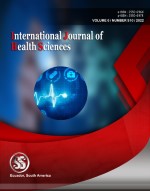When is the right time brush the teeth to neutralize the acidity of Saliva after eating a snack
Keywords:
brushing teeth, Saliva PH, time, refined carbohydratesAbstract
In Indonesia, there is a change in diet due to refined carbohydrates, a type of food that is favoured and consumed by children. If we do not brush our teeth right away, the rest of the food is turned into acid by bacteria and causes dental caries. This study aims to determine the most appropriate time for brushing teeth to neutralize the acidity of Saliva after consuming a snack. Research design Quasi-Experimental One Group Pre and post-test design by involving the entire population of 60 people. Data analysis using the Wilcoxon test to prove the effect of before and after brushing teeth after a snack and Friedman’s test to see the effect on the treatment time group. The results of the study are the degree of acidity (pH) of Saliva pre and post brushing teeth 5 minutes after eating an average of 5.85 decreased by 5.60, 15 minutes after eating an average of 5.78 increased by 6.02, and 30 minutes after eating an average of 5.68 increased by 6.10.
Downloads
References
Magdalene. Study of Energy, Carbohydrate, Protein, and Fat Consumption Levels in Obese Children Age 2-12 Years in Banjarmasin City (Magdalena). Al'Ulum. 2012;54(4):29-33.
Andayasari L, Anorital. Relationship of cariogenic food consumption with the dental health status of kindergarten children in Banten Province and Yogyakarta Special Region in 2014. Proceedings of SNaPP2016 Health. 2016;6(1):40-47. http://proceeding.unisba.ac.id/index.php/kesehatan/article/view/1442
Ramayanti S, Purnakarya I. The Role of Food on the Incidence of Dental Caries. J May Health. 2013;7(2):89-93. http://jurnal.fkm.unand.ac.id/index.php/jkma/article/view/114/120
Putri RM, Maemunah N, Rahayu W. The Relationship between Dental Caries and Nutritional Status of Pre-School Children. 123 Care. 2017;5(1):123-129.
Gopdianto R, Rattu AJM, Mariati NW. Status of Oral Hygiene and Toothbrushing Behavior of Children at State Elementary School 1 Malalayang. e-GIGI. 2014;3(1). doi:10.35790/eg.3.1.2015.6457
Sriyono NW. Introduction to Dentistry. Medika FKG UGM; 2005.
Narendra ARA, Rosalinah Y, Priadi A, et al. Basic Series Statistics With SPSS .; 2021.
Kasuma N. Saliva Physiology and Pathology. Andalas University Press; 2015.
Oktarianda B. Relationship of Time, Teeth Brushing Techniques, and Types of Food Consumed with Dental Caries Incidence in Students of SDN 66 Payakumbuh at Lampasi Payakumbuh Health Center, published online 2011.
Asridiana A, Thioritz E. The Effect of Consuming Sweet and Sticky Foods on Saliva pH in Students at SDN Mamajang Makassar. Media for Dental Health, Health Polytechnic Makassar. 2019;18(1):34-40. doi:10.32382/mkg.v18i1.896
Praptiningsih RS, Ningtyas EAE. Effect of Brushing Method before Eating on Bacterial Quantity and Saliva pH. Maj Ilm Sultan Agung. Published online 2014:4235-4235. doi:10.1007/978-1-4614-5690-2_100564
Hidayat S, Adhani R, Arya IW. Differences in Saliva pH Brushing Teeth Before and After Consuming Sweet and Sticky Foods. J Dentist . 2014;II(1):39-45.
Govindaraju L, Gurunathan D. Effectiveness of chewable toothbrush in the children-a prospective clinical study. J Clin Diagnostics Res . 2017;11(3): ZC31-ZC34. doi:10.7860/JCDR/2017/24238.9528
Triswari D, Dian Pertiwi A. Effects of Brushing Your Teeth Before Sleeping at Night on Plaque Index Scores and Saliva pH. Incisive Dent J Maj Incisive Dentistry. 2017;6(2):1-8. doi:10.18196/di.6282
Lely MA. Effect (pH) of Saliva on the Occurrence of Dental Caries in Preschool-Age Children. Bul Health Researcher. 2017;45(4). doi:10.22435/bpk.v45i4.6247241-248
Harapan K, Tahulending AA, Andolo SI. Differences in the pH of Saliva were brushing teeth before and after consuming sweet food in 7th-grade students of SMP Negeri 05 Tuminting, Manado Municipality. JIM (Journal of Dental and Oral Science). 2019;2(1):19-25.
Published
How to Cite
Issue
Section
Copyright (c) 2022 International journal of health sciences

This work is licensed under a Creative Commons Attribution-NonCommercial-NoDerivatives 4.0 International License.
Articles published in the International Journal of Health Sciences (IJHS) are available under Creative Commons Attribution Non-Commercial No Derivatives Licence (CC BY-NC-ND 4.0). Authors retain copyright in their work and grant IJHS right of first publication under CC BY-NC-ND 4.0. Users have the right to read, download, copy, distribute, print, search, or link to the full texts of articles in this journal, and to use them for any other lawful purpose.
Articles published in IJHS can be copied, communicated and shared in their published form for non-commercial purposes provided full attribution is given to the author and the journal. Authors are able to enter into separate, additional contractual arrangements for the non-exclusive distribution of the journal's published version of the work (e.g., post it to an institutional repository or publish it in a book), with an acknowledgment of its initial publication in this journal.
This copyright notice applies to articles published in IJHS volumes 4 onwards. Please read about the copyright notices for previous volumes under Journal History.
















